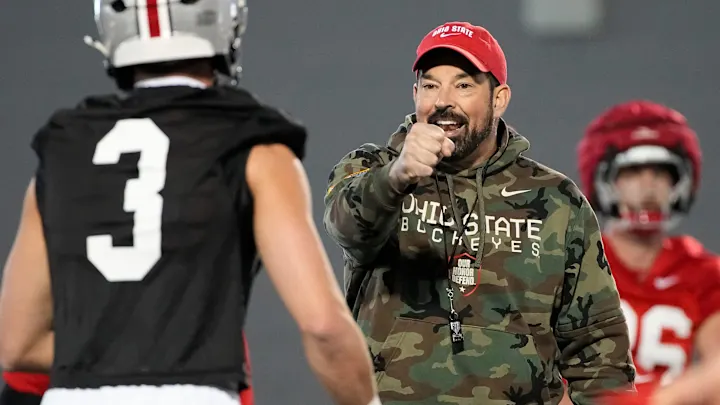
The college football world has witnessed rapid changes in recent years, most notably with the rise of the NCAA’s transfer portal. For coaches, players, and fans alike, the portal has been a game-changer, reshaping the landscape of college football with its implications for team rosters, recruiting, and even game-day strategies. Ryan Day, the head coach of the Ohio State Buckeyes, recently made headlines with a reaction to the closing of the transfer portal that many fans, players, and fellow coaches could relate to. His candid and genuine response captured not just the frustration and uncertainty that many coaches feel, but also the inherent challenges of managing a team in the new age of college football.
The Transfer Portal: A New Era in College Football
To understand Ryan Day’s reaction, it’s essential to first grasp what the transfer portal is and why it’s become such a pivotal aspect of college football. Introduced in 2018 by the NCAA, the transfer portal allows student-athletes to declare their intention to transfer from one university to another and opens up a window for coaches to recruit these athletes from other programs. Once a player enters the portal, their information becomes publicly available to any coach interested in them, and they are free to negotiate and transfer to other schools.
The implications of the transfer portal are multifaceted. On one hand, it gives student-athletes more freedom and mobility, allowing them to leave a school if they feel like they’re not getting the playing time or academic support they deserve. On the other hand, the portal has created a sense of instability for college football programs. Teams that once prided themselves on having a stable roster are now constantly in flux as players transfer in and out.
Moreover, for coaches, the portal is both a blessing and a curse. On one hand, it gives them the ability to bring in new talent that can immediately impact their programs. However, it also forces them to deal with constant turnover and the pressure of trying to keep their current players happy, knowing that any of them could enter the portal at any time. For many coaches, managing a roster in the transfer portal era requires more time and effort than ever before.
Ryan Day’s Relatable Response to the Closing of the Transfer Portal
Ryan Day, who took over as the head coach of Ohio State in 2019, has already experienced the highs and lows of college football, including leading the Buckeyes to numerous Big Ten championships and national championship appearances. But like many of his coaching peers, Day has found the rise of the transfer portal to be a complicated and sometimes frustrating experience.
When the NCAA’s transfer portal officially closed for the spring window in 2025, Day’s reaction was one that many could empathize with. During a press conference, Day was candid about the challenges he faced in managing his roster amidst the portal’s constant shifting landscape. His remarks reflected the real concerns of coaches across the country as they scrambled to secure talent and avoid losing key players to other programs.
Day’s comments included a mixture of exasperation, humor, and a sense of vulnerability that made his response so relatable. In essence, Day’s frustration stemmed from two primary issues: the unpredictability of player movement and the lack of clear guidelines or stability that the portal creates for team-building.
The Unpredictability of the Portal
One of the most significant challenges that Ryan Day and other coaches face in the transfer portal era is the sheer unpredictability of player movement. In the past, coaches could build a roster with a sense of continuity. Players were typically recruited and stayed at their programs for multiple seasons, barring rare transfers. However, with the transfer portal in place, this stability has been replaced by a sense of constant uncertainty.
As Day noted, it’s difficult to plan for the future when players can leave at any moment. The transfer portal has become a double-edged sword for coaches. While it can be a tool for bolstering a team’s roster with talent from other programs, it also forces coaches to constantly manage their rosters to avoid being caught off-guard. In Day’s case, Ohio State’s football program has been among the most successful in the country, meaning that they’ve often been able to attract top-tier players from other schools. Yet, that same success has also made them a target for transfers seeking better opportunities.
Moreover, the unpredictability of the transfer portal can cause a sense of chaos. Players can enter the portal at the most inopportune times, disrupting a coach’s plans for the upcoming season. In his remarks, Day alluded to how he sometimes felt like he was playing defense rather than focusing on long-term strategy, as the threat of losing players to the portal loomed large. Coaches must always be on guard, constantly monitoring their players’ statuses while also trying to recruit new players to fill potential gaps. This constant state of flux makes team-building far more complicated than it was in the pre-portal era.
The Lack of Stability and Clear Guidelines
Another frustration that Day expressed was the lack of clear guidelines and structure around the transfer portal process. While the NCAA has implemented some rules to regulate the portal, many aspects of it remain ambiguous and open to interpretation. For example, the NCAA established windows for when players can enter the portal, but coaches and administrators often feel that these guidelines aren’t enough to ensure a smooth process. The lack of transparency and consistency makes it harder for coaches like Ryan Day to operate with confidence.
The transfer portal’s open-ended nature has also led to an increase in “tampering” – where schools allegedly reach out to players already enrolled at other institutions in an effort to persuade them to transfer. Although the NCAA has rules in place to prevent tampering, enforcing them has proven difficult, leading to frustrations among coaches. Day acknowledged this issue, noting that tampering and illegal recruitment have become serious problems in the modern college football landscape.
Furthermore, there’s the issue of the “immediate eligibility” rule, which allows players who transfer to play right away without sitting out a year. This rule has undoubtedly increased the frequency of transfers, but it has also created a scenario where coaches have less control over roster changes and must make quicker decisions. Day’s comment on this point highlighted the challenge of balancing the desire to bring in new players with the potential instability caused by losing established talent.
The Human Side of Coaching in the Transfer Portal Era
Beyond the strategic and logistical concerns, Ryan Day’s reaction to the transfer portal also touched on the emotional toll that it takes on coaches. College football is often seen as a business, but at its core, it’s about relationships. Coaches like Day invest a significant amount of time and energy into building connections with their players, mentoring them both on and off the field. The rise of the transfer portal has made it harder for coaches to maintain those long-term relationships, as players come and go with increasing frequency.
In his response, Day expressed empathy for the players involved in the transfer process. While coaches are often criticized for making decisions that affect players’ careers, Day acknowledged that the players themselves face immense pressure when it comes to making decisions about their future. The pressure to perform, the desire for more playing time, and the reality of changing coaching staffs all factor into a player’s decision to enter the portal. Day’s ability to empathize with players, even while dealing with the chaos of the portal, made his reaction all the more human and relatable.
Ryan Day’s reaction to the closing of the transfer portal encapsulated the challenges and frustrations that many coaches face in the modern landscape of college football. From the unpredictability of player movement to the lack of clear guidelines, Day’s candidness shed light on the complexities of managing a program in the transfer portal era. His frustration was not just about losing players or the challenges of recruiting; it was about the lack of stability and control that coaches once took for granted.
In a time when the rules of college football are constantly shifting, Day’s reaction served as a reminder of the human element behind the X’s and O’s. Coaches like him are not only tasked with developing talent but also managing a dynamic and ever-changing environment where the stakes are higher than ever. As the transfer portal continues to evolve, one thing remains clear: Ryan Day’s relatable reaction is a reflection of the many coaches who are learning to adapt and navigate this new era of college football, one unpredictable transfer at a time.





